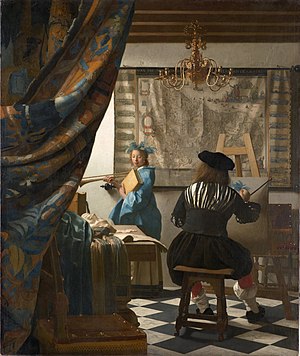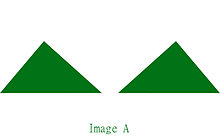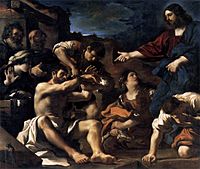7 Elements of Art Space Photographs That Show Form Element

The term composition means "putting together". Information technology can be thought of as the organization of the elements of art co-ordinate to the principles of fine art. Composition can apply to any work of art, from music through writing and into photography, that is arranged using conscious idea.
In the visual arts, composition is ofttimes used interchangeably with diverse terms such equally pattern, form, visual ordering, or formal structure, depending on the context. In graphic blueprint for press and desktop publishing, limerick is commonly referred to as page layout.
The composition of a picture show is unlike from its subject (what is depicted), whether a moment from a story, a person or a identify. Many subjects, for example Saint George and the Dragon, are often portrayed in fine art, only using a nifty range of compositions fifty-fifty though the ii figures are typically the only ones shown.
Elements of design [edit]
The cardinal visual element, known as element of design, formal element, or element of art, constitute the vocabulary with which the visual artist compose. These elements in the overall design ordinarily relate to each other and to the whole fine art work.
The elements of design are:
- Line — the visual path that enables the center to move within the piece
- Shape — areas defined by edges inside the piece, whether geometric or organic
- Color — hues with their various values and intensities
- Texture — surface qualities which translate into tactile illusions
- Value — Shading used to emphasize form
- Form — 3-D length, width, or depth
- Space — the space taken upwardly past (positive) or in between (negative) objects
Line and shape [edit]

Lines are optical phenomena that permit the creative person to direct the centre of the viewer. The optical illusion of lines do be in nature, and visual arts elements can be arranged to create this illusion. The viewer unconsciously reads near the continuous system of unlike elements and subjects at varying distances. Such elements tin exist of dramatic use in the composition of the image. These could exist literal lines such every bit telephone and power cables or rigging on boats. Lines can also derive from the borders of different colors or contrast or sequences of discrete elements. Movement is also a source of lines, where the blurred movement renders equally a line.[1]
Subject lines contribute to both mood and linear perspective, giving the viewer the illusion of depth. Oblique lines convey a sense of movement, and angular lines mostly convey dynamism and possibly tension. Lines can also directly attention towards the main subject field of the pic or contribute to the organization by dividing it into compartments. The creative person may exaggerate or create lines, maybe equally part of their message to the viewer. Many lines without a articulate field of study point suggest chaos in the epitome and may conflict with the mood the artist is trying to evoke.[ citation needed ]
A line's angle and its relationship to the frame's size influence the perspective of the image. Horizontal lines, usually found in mural photography, can give the impression of calm, tranquility, and space. An image filled with strong vertical lines tends to have the appearance of pinnacle and grandeur. Tightly angled convergent lines give a dynamic, lively, and active issue to the paradigm. Firmly turned, almost diagonal lines produce tension in the moving picture. The viewpoint of visual art is key because every different perspective views different angled lines. This alter of perspective elicits a different response to the image. Changing the air only by some degrees or some centimeters lines in embodiments can vary tremendously, and a distinct feeling tin be transported. Straight lines are also strongly influenced by tone, color, and repetition concerning the rest of the paradigm.
Compared to straight lines, curves provide a greater dynamic influence in a picture. They are also generally more aesthetically pleasing, equally the viewer associates them with softness. In photography, curved lines can give graduated shadows when paired with soft-directional lighting, which usually results in a very harmonious line structure within the epitome. In that location are 2 main types of curves, a simple "C" curve as well as a more than sinuous "S" curve.[2]
Color [edit]
There are 3 properties of color: hue, brightness or blush, and value. Hue is the name of a colour (ruddy, yellow, and blue, etc.). Brightness and chroma refer to the intensity and forcefulness of the colour. A high blush color is more pure and less greyed than a depression blush colour. The lightness or darkness to a colour is the value. Color also has the power to work inside our emotions. Given that, we tin can use color to create mood. It can also be used as tone, design, light, motility, symbol, grade, harmony, and dissimilarity.[3] [4]
Texture [edit]
Texture refers to how an object feels or how it looks similar it may feel if it were touched. There are two ways we experience texture, physically and optically. Dissimilar techniques can be used to create physical texture, which allows qualities of visual art to be seen and felt. This tin include surfaces such every bit metal, sand, and wood. Optical texture is when the illusion of physical texture is created. Photography, paintings, and drawings apply visual texture to create a more realistic advent.[5]
Value [edit]
Lightness and darkness are known as value in visual fine art. Value deals with how light reflects off objects and how nosotros meet information technology. The more than low-cal that is reflected, the higher the value. White is the highest or lightest value while black is the lowest or darkest value. Colors likewise have value; for example, xanthous has a high value while blue and red have a low value. If you accept a black and white picture of a colorful scene, all you are left with are the values. This important element of blueprint, peculiarly in painting and drawing, allows the artist to create the illusion of light through value contrast.[6]
Form [edit]
The term form tin can hateful different things in visual art. Grade suggests a three-dimensional object in infinite. Information technology is also described equally the concrete nature of the artwork, such as sculptures. Information technology can also be looked at as art form, which can exist expressed through fine art. A form encloses volume, has length, width, and height, dissimilar a shape, which is merely two-dimensional. Forms that are mathematical, a sphere, pyramid, cube, cylinder, and cone, are known as geometric forms. Organic forms are typically irregular and asymmetrical. This course can be found in nature, such equally flowers, rocks, trees, etc., just tin also be seen in compages.[7]
Forms in cartoon and painting convey the illusion of 3-dimensional class through lighting, shadows, value, and tone. The more dissimilarity in value, the more pronounced the three-dimensional class is. Forms with little value announced flatter than those with greater variation and contrasting.
Space [edit]
Infinite is the area around, to a higher place, and inside an object. Photographers can capture infinite, architects build infinite, and painters create space. This element is constitute in each of the visual arts. Information technology tin be positive or negative, open or closed, shallow or deep, and two-dimensional or three-dimensional. In cartoon or painting, infinite is non actually there, but the illusion of it is. Positive space is the subject of the piece. The empty spaces around, above, and within, is negative space.[eight] [9]
Principles of organization [edit]
The artist determines what the heart of interest (focus in photography) of the fine art work will be, and composes the elements accordingly. The gaze of the viewer volition then tend to linger over these points of interest, elements are bundled with consideration of several factors (known variously every bit the principles of system, principles of art, or principles of design) into a harmonious whole which works together to produce the desired statement – a phenomenon ordinarily referred to equally unity. Such factors in composition should non be confused with the elements of art (or elements of pattern) themselves. For example, shape is an element; the usage of shape is characterized by various principles.
Some principles of organization affecting the limerick of a flick are:
- Shape and proportion
- Positioning/orientation/balance/harmony among the elements
- The area inside the field of view used for the picture ("cropping")
- The path or direction followed past the viewer's eye when they find the image.
- Negative space
- Color
- Contrast: the value, or degree of lightness and darkness, used within the picture.
- Organization: for example, use of the golden mean or the rule of thirds
- Lines
- Rhythm
- Illumination or lighting
- Repetition (sometimes building into pattern; rhythm also comes into play, as does geometry)
- Perspective
- Breaking the rules can create tension or unease, yet it can add interest to the motion-picture show if used carefully
Viewpoint (leading with the eye) [edit]
The position of the viewer can strongly influence the aesthetics of an epitome, even if the subject is entirely imaginary and viewed "inside the listen's eye". Not just does information technology influence the elements within the motion picture, but it also influences the viewer's interpretation of the subject.
For instance, if a male child is photographed from above, peradventure from the eye level of an adult, he is diminished in stature. A photograph taken at the child's level would treat him equally an equal, and one taken from below could outcome in an impression of authority. Therefore, the photographer is choosing the viewer's positioning.
A subject can be rendered more dramatic when it fills the frame. At that place exists a tendency to perceive things as larger than they really are, and filling the frame fulfills this psychological mechanism. This tin can be used to eliminate distractions from the background.
In photography, altering the position of the camera can change the image so that the discipline has fewer or more distractions with which to compete. This may be achieved past getting closer, moving laterally, tilting, panning, or moving the camera vertically.
Compositional techniques [edit]
There are numerous approaches or "compositional techniques" to reach a sense of unity within an artwork, depending on the goals of the creative person. For example, a work of art is said to be aesthetically pleasing to the centre if the elements within the piece of work are bundled in a balanced compositional manner.[ten] However, there are artists such every bit Salvador Dalí who aim to disrupt traditional composition and challenge the viewer to rethink balance and design elements inside art works.
Conventional composition can be achieved with a number of techniques:
Rule of thirds [edit]
The dominion of thirds is a composition guide that states that arranging the important features of an image on or near the horizontal and vertical lines that would separate the image into thirds horizontally and vertically is visually pleasing. The objective is to stop the subjects and areas of interest (such equally the horizon) from bisecting the prototype, past placing them near one of the lines that would carve up the image into three equal columns and rows, ideally near the intersection of those lines.

Rule of thirds: Note how the horizon falls close to the lesser filigree line, and how the dark areas are in the left 3rd, the overexposed in the right third.
The rule of thirds is thought to be a simplification of the gold ratio. The gilded ratio is idea to accept been used past artists throughout history as a composition guide, but there is lilliputian evidence to back up this claim.
Rule of odds [edit]
The "rule of odds" suggests that an odd number of subjects in an image is more interesting than an even number. Thus if yous accept more than one discipline in your film, the suggestion is to choose an arrangement with at to the lowest degree three subjects. An even number of subjects produces symmetries in the paradigm, which can appear less natural for a naturalistic, informal composition.
An image of a person surrounded/framed past 2 other persons, for instance, where the person in the middle is the object of involvement in that image/artwork, is more likely to be perceived as friendly and comforting by the viewer, than an epitome of a unmarried person with no significant environs.
Rule of infinite [edit]

Image of a racing car with lead room
The rule of space applies to artwork (photography, advertizement, illustration) picturing objects to which the artist wants to employ the illusion of movement, or which is supposed to create a contextual chimera in the viewer's mind.
This can exist achieved, for example, by leaving white infinite in the direction the eyes of a portrayed person are looking, or, when picturing a runner, calculation white space in front of him rather than behind him to betoken movement.
Simplification [edit]
Images with clutter tin distract from the main elements within the picture and make it difficult to identify the subject. By decreasing the extraneous content, the viewer is more than likely to focus on the chief objects. Clutter tin can also be reduced through the use of lighting, as the brighter areas of the epitome tend to depict the heart, as practise lines, squares and color. In painting, the artist may use less detailed and defined brushwork towards the edges of the picture. Removing the elements to the focus of the object, taking only the needed components.
Shallow depth of field [edit]
In photography, and besides (via software simulation of existent lens limitations) in 3D graphics, ane approach to achieving simplification is to use a wide aperture when shooting to limit the depth of field. When used properly in the right setting, this technique can identify everything that is not the bailiwick of the photo out of focus.
| The blurred background focuses the eye on the flowers. | At a smaller discontinuity, the background competes for the viewer'south attention. |
A similar approach, given the right equipment, is to have advantage of the Scheimpflug principle to change the plane of focus.
Geometry and symmetry [edit]

A simple composition with cloud and rooftop that creates disproportion.
Related to the rule of odds is the observation that triangles are an aesthetically pleasing unsaid shape within an image. In a canonically attractive confront, the rima oris and optics autumn within the corners of the expanse of an equilateral triangle.[ citation needed ] Paul Cézanne successfully used triangles in his compositions of still lifes. A triangular format creates a sense of stability and strength.
Creating movement [edit]
Information technology is generally thought to be more pleasing to the viewer if the image encourages the eye to move around the image, rather than immediately fixating on a single place or no place in particular. Artists volition often strive to avert creating compositions that feel "static" or "flat" by incorporating movement into the paradigm. In image A the ii mountains are equally sized and positioned beside each other creating a very static and uninteresting image. In image B the mountains are differently sized and one is placed closer to the horizon, guiding the eye to move from one mountain to the other creating a more than interesting and pleasing image. This also feels more than natural because in nature objects are rarely the same size and evenly spaced.


Other techniques [edit]
- There should be a center of interest or focus in the piece of work, to prevent it becoming a pattern in itself
- The direction followed by the viewer's eye should pb the viewer's gaze around all elements in the work before leading out of the pic
- The subject should not exist facing out of the image
- Exact bisections of the picture infinite should be avoided
- Small, high contrast, elements have every bit much impact as larger, duller elements
- The prominent subject area should be off-heart, unless a symmetrical or formal composition is desired, and tin can be balanced by smaller satellite elements
- The horizon line should not divide the art piece of work in 2 equal parts but be positioned to emphasize either the heaven or ground; showing more sky if painting is of clouds, sun ascent/set, and more ground if a landscape
- Use of detailed areas and 'balance' areas tin help to aid the eye in where to look. Creating a contrast between detail and lack of detail is important
These principles tin exist means of a good composition yet they cannot exist applied separately but should human activity together to form a good limerick.
- Besides in an artwork, it is suggested that no spaces between the objects should exist the same to create a more than interesting image.
Case [edit]
These paintings all bear witness the same subject, the Raising of Lazarus, and essentially the same figures, simply accept very dissimilar compositions:
See also [edit]
- Miksang (contemplative photography)
- New Epoch Notation Painting (a notation system for painting)
- Folio layout (graphic design)
- CLACL (a reckoner linguistic communication for composition)
- List of photographic composition techniques
References [edit]
- ^ Wrigley, Alex. "How to Use Leading Lines in Your Photography Limerick". Click and Larn Photography . Retrieved 6 February 2019.
- ^ Taylor, David (21 February 2015). Understanding Composition: The Expanded Guide. Eastward Sussex: Ammonite Press. p. 68. ISBN9781781451083.
- ^ Esaak, Shelley. "What is the Definition of Color in Fine art?". ThoughtCo . Retrieved March viii, 2017.
- ^ "Element of Design: Color". Fine art Foundations. Archived from the original on 2018-12-23. Retrieved 2018-04-03 .
- ^ "The Visual Elements". Artyfactory.
- ^ Fussell, Matt. "The Elements of Art-"Value"". The Virtual Instructor.
- ^ Marder, Lisa. "What Does the Term 'Class' Mean in Regards to Art?". ThoughtCo . Retrieved January 23, 2018.
- ^ Esaak, Shelley. "Exploring the Spaces Betwixt and Inside Us". ThoughtCo . Retrieved February 19, 2018.
- ^ "What is Infinite?". Sophia. Sophia Learning.
- ^ Dunstan, Bernard. (1979). Composing Your Paintings. London, Studio Vista.
Further reading [edit]
- Arnheim, Rudolf (1974). Fine art and Visual Perception: A Psychology of the Creative Heart. University of California Press. ISBN978-0-520-02613-1.
- Downer, Marion (1947). Discovering Design. Lothrop Lee & Shepard. ISBN0-688-41266-1.
- Graham, Peter (2004). An Introduction to Painting Nevertheless Life . Chartwell Books Inc. ISBN0-7858-1750-6.
- Grill, Tom; Scanlon, Mark (1990). Photographic Composition. Watson-Guptill Publications. ISBN0-8174-5427-6.
- Peterson, Bryan (1988). Learning to See Creatively . Watson-Guptill Publications. ISBN0-8174-4177-viii.
- Langford, Michael (1982). The Master Guide to Photography. New York: Dorling Kindersley Limited. ISBN0-394-50873-4.
External links [edit]
- Percy Principles of Art and Composition, Goshen College Fine art Department
- Using Detail and why it is of import
Source: https://en.wikipedia.org/wiki/Composition_(visual_arts)






Postar um comentário for "7 Elements of Art Space Photographs That Show Form Element"